How Should I Drink Sake?
Although saké is typically served chilled or at room temperature, warming it up is also a great way to really excrete the aromas and taste, and it is often used in Japanese cuisine as a condiment or to accompany meals.

It is important to note that warming up saké can alter its flavor and aroma, so it is best to do it gently and carefully. If you prefer a more traditional method, you can also use a saké warmer, which is a ceramic or metal container specifically designed for heating saké. These are available at many specialty kitchen stores or online. We’ve compiled four ways to warm up your saké listing some of the pros and cons that come with it.

Quick Note Before You Start
Before we get started, I just wanted to share that one of the sakés that I like to use to start my saké warming journey is the Gekkeikan saké. It’s a standard easy saké to experiment with and yummy as well. Also, a Tokkuri set is a custom and fancy way to pour your warm sake when you have guests over. I will put some links to Tokkuri sets down below. Without further adu, let’s get right into it.
(Product link to electric sake warmer)
4 Easy Ways To Warm Up Your Saké
(x3 Product link to different Tokkuri Sets)
1: Using a Microwave
Put your saké into a heat-resistant glass or any microwave-safe container that is smaller to get it into the microwave. Pop it into the microwave with some plastic wrap over the opening as it helps to trap the heat and heat the vessel more evenly. Of course, I use something ceramic or porcelain for safety. You should heat it in short bursts, stirring between each burst, until it reaches the desired temperature.
Pour your warm saké into your Tokkuri set or if you have traditional smaller porcelain cups too. If you have a thermometer it will help you with your temperature check and control much better.
When you have everything set up, give the Tokkuri a little swirl to mix the saké up and equalize the temperature. If you don’t have a thermometer you can touch the recessed bottom of the Tokkuri to get a better idea of the sake temperature by hand., or just use your thermometer. Pour your sake and enjoy.
Pros: This method is quick and convenient if you have a microwave in your home.
Cons: The temperature can be imprecise and there’s a chance that the saké won’t heat up evenly.
2: Transitional Hot Water Bath Method.
First, fill your Tokkuri with the saké of your choice. Then, place a large bowl of hot water on your counter, and put your Tokkuri filled with saké inside the bowl. You can get the hot water straight from the tap or heat it up in a kettle. Either way, the water should go up at least halfway up the Tokkuri vessel. After a while, raise the vessel and check the bottom of the Tokkuri or use a thermometer to do a temperature check. Once you feel the temperature that you prefer, then you are all set.
Pros: The transitional process is very cathartic and it can provide a more accurate temperature control.
Cons: The process takes a slightly longer time
3: Single Cup Warming Method.
Boil water in a kettle or whichever way is most convenient for you. You will need a heat resistant glass to pour the boiling water into. Pour the water into the glass and let the glass sit with the boiling hot water. Then discard the water leaving only the hot glass behind.
Finally, you can pour your room-temperature saké into the glass, and voila. You should have a warm saké in just a couple of seconds. Some benefit to having your saké not hot, but just slightly warmer than room temperature is that you can really taste the different flavor profiles when you do this.
Pros: Perfect for small servings and no special tools required
Cons: Only good for small servings. Warms the saké but doesn’t make it hot.
4: Sous Vide Method:
Fill your Tokkuri all the way to the top with your saké, and set your Sous Vide machine to the temperature you want. Once the water in the Sous Vide machine is at the exact temperature you want, set your full Tokkuri into the water. Set the timer and now you can take your eyes off it.
Pros: This will provide perfect temperature control and is great for serving large groups.
Cons: On the other hand, you will need a Sous Vide machine to perform this method.
(Product link for a Sous Vide Machine)
How Is Saké Made?
Japanese saké is frequently used in traditional Japanese ceremonies and rituals. Japanese saké, also known as “Nihonshu,” is a type of rice wine that is traditionally made in Japan. It is made by fermenting rice that has been polished to remove the outer layers, and exposing the starchy center. The rice is mixed with water and a type of fungus called “koji,” which helps to convert the starch in the rice into sugars. The mixture is then fermented with yeast, and the resulting liquid is filtered and bottled.

There are several different types of saké, which vary in terms of flavor, aroma, and alcohol content. Some of the most common types include Junmai, Ginjo, and Daiginjo. Junmai saké is made with only rice, water, and koji, and it tends to have a bold, earthy flavor. Ginjo and Daiginjo sakés are made with rice that has been more highly polished, and they tend to have a smoother, more delicate flavor.
Saké is often mistaken for rice wine, but it is actually quite different from other types of rice wine. One key difference is that saké is made using a specific type of rice called “sakamai,” which is polished to a much greater degree than the rice used in other types of rice wine. This results in a smoother, more refined flavor. Additionally, saké is typically made using a different fermentation process than other types of rice wine, which gives it a distinct flavor and aroma.
In Japan, saké is an important part of the country’s culture and history, and it is enjoyed by people of all ages. It is often served at special occasions and celebrations, and it is also enjoyed as an everyday drink. If you’re interested in trying saké, there are many different brands and types available, and it is widely available in Japan and other countries around the world.
Conclusion
There you have it, four easy ways to heat up your saké. Do you have a different way of heating up your sake at home? What kind of cocktails have you tried that incorporate saké? Let us know in the comments below? Remember, stay home and get hammered!























